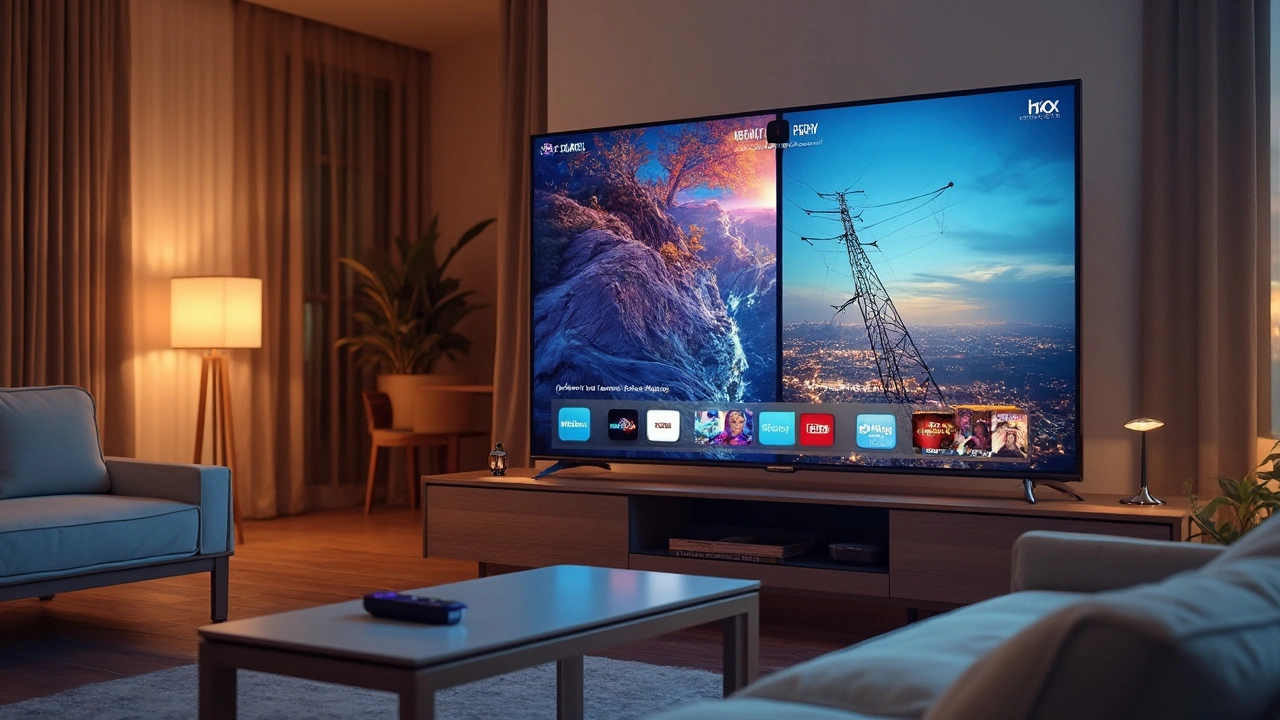So you're curious about whether a Roku TV comes with a built-in antenna? It's a question more folks ask than you might think. Ever since the advent of streaming services, traditional TV viewing has taken a backseat, but there are still plenty of us who appreciate the good old over-the-air broadcasts.
Roku TVs are fantastic at turning your living room into a streaming paradise. With access to a myriad of apps like Netflix, Hulu, and Disney+, there’s no shortage of options. However, when it comes to traditional broadcasting, things get a bit different. Spoiler: they don't have antennas hidden inside. For those live channels and local stations, you’ll still need an external antenna.
Before you make a run to the store, or start repositioning the furniture in your living room, it's key to understand how Roku TVs handle broadcast television. They come equipped with a TV tuner for this very purpose, but that magical built-in antenna people hope for? It’s missing in action, and yet, there's a silver lining; it’s fairly simple to hook up an antenna yourself.
- Understanding Roku TV Basics
- The Antenna Mystery
- Streaming Meets Traditional TV
- Getting More with an External Antenna
- Setting Up Your Roku TV for Broadcasts
- Pros and Cons of Roku TV for Broadcasts
Understanding Roku TV Basics
Alright, let’s break down what makes Roku TV tick. At its core, a Roku TV is smart television that comes with the Roku operating system built right in. Instead of needing a separate Roku streaming device, everything is set up internally, so you just need to turn it on and start watching.
On the surface, they're similar to regular smart TVs, but the easy-to-use Roku interface is what really sets them apart. This interface acts as the hub for all your digital entertainment, allowing seamless streaming from popular services like Netflix and Hulu without the hassle of switching devices or plugging in extra hardware. Users often rave about the user-friendly design that makes navigation a breeze.
Not Just Streaming: Built-in Features
Even though they’re all about that streaming life, Roku TVs come equipped with old-school TV functionalities, including an HDMI port, USB ports, and most importantly, a built-in TV tuner. Yep, this means you can hook up cable or even an external antenna for local channels.
A lesser-known fact is their compatibility with voice controls. Some models support voice commands through Alexa, Google Assistant, and even Roku's own voice control. That means you can just ask your TV to play 'The Mandalorian' or turn down the volume—all without lifting a finger.
No Built-in Antenna
It’s important to confirm that while Roku TVs have that handy built-in tuner, they don't have a built-in antenna for broadcasting purposes. To catch over-the-air channels, you'll need to attach an external antenna through the coaxial input. This option lets you enjoy the best of both worlds: cable-like access to local news and sports while keeping your streaming services ready to roll.
So, in essence, a Roku TV is an all-in-one solution for modern viewing needs. Whether you're flipping through traditional broadcast channels or streaming the latest series online, it’s got you covered, as long as you don’t mind adding a few extras for the complete package.
The Antenna Mystery
Let's tackle the burning question: do Roku TVs come with a built-in antenna? The simple answer is no. Many people get confused, thinking that these smart TVs are equipped to pull in broadcast channels straight out of the box. While they're excellent for streaming, their broadcast capabilities require a bit more.
Roku TVs come ready with a TV tuner, which is awesome for picking up local broadcast channels. But to get this functioning, you'll need an external antenna. Think of the TV tuner like a catcher’s mitt. It’s ready and waiting, but you’ve got to supply the ball, or in this case, the antenna. This means you'll be able to enjoy over-the-air content along with your streaming playlists.
According to a
study by Consumer Reports, "Many newer televisions have built-in tuners, but lack a built-in antenna to receive local channels. An external antenna is necessary to benefit from the free programming over the air."This makes sense when you consider that TVs don't typically include antennas as built-in features. They expect you to make a little extra effort for that extra bit of functionality.
But don’t worry, adding an antenna is not a mission impossible. Most options are affordable and user-friendly. A quick trip to any electronics store will show you a variety, from simple rabbit ears to more sophisticated digital ones. Just connect one end to your Roku TV and position the other for the best signal.
Streaming services and traditional broadcasts make a surprisingly beautiful combo once you’ve got your antenna set up. You can blend the new age streaming world with the classic open-air waves, giving you the best of both worlds right from one screen.
Streaming Meets Traditional TV
It’s an exciting time for entertainment; we've got the best of both worlds with Roku TVs kicking it off. While the Roku TV primarily caters to our modern binge-watching habits, facilitating access to countless streaming services, it hasn't entirely abandoned the charm of traditional TV.
Here’s the deal: Roku isn’t just about going online. You can still enjoy those local news segments or favorite network shows without missing out. The TV set incorporates a TV tuner that lets you connect an external antenna, bringing free-to-air channels directly into your living room. So, it’s possible to enjoy over-the-air broadcasts along with the entire streaming shebang.
Blended Viewing Experience
This setup means more flexibility for Roku TV users. Imagine catching the latest happening on a local news channel and then diving back into the thrilling world of Netflix – all without switching devices. Roku lets you arrange both your streaming channels and antenna-based stations in one convenient interface.
To navigate this hybrid viewing world effectively, follow these steps once you've hooked up an antenna:
- Go to the home screen on your Roku TV, using the remote.
- Navigate to the 'Antenna TV' option (sometimes labeled as 'Live TV').
- Initiate a channel scan to ensure all available channels are registered.
- Organize your channels, possibly creating a 'Favorites' list for easy access to your preferred ones.
Roku TV: A Robust Entertainment Hub
Switching between streaming and traditional TV channels is seamless with Roku, almost as if they're bridging two different eras of television into a smooth experience. Users are particularly delighted by how content from both sources appears uniform on the Roku TV interface, eliminating any sense of division.
This synergy between streaming and traditional viewing options not only leaves you spoilt for choice but also makes the viewing environment more adaptive, catering to diverse tastes and preferences.

Getting More with an External Antenna
Adding an external antenna to your Roku TV can open up a whole new world of entertainment. If you're someone who loves catching live sports games, morning news, or the odd late-night movie on local channels, this is for you.
First off, let's get to the basics. Roku TVs have a built-in tuner, which means they can pick up signals from an antenna. To start, you’ll need to purchase an external antenna. These come in all shapes and sizes, from small indoor varieties to more powerful outdoor units. Your choice largely depends on how far you live from the nearest broadcast tower and how many channels you want to pull in.
Choosing the Right Antenna
If you're close to a city, an indoor antenna will likely do the trick. They’re affordable and can snag quite a few channels. On the other hand, if you're in a rural spot, you might need a beefier outdoor antenna. Websites like AntennaWeb or TV Fool can help you figure out what's best based on your ZIP code.
Setting It Up
Once you've got your antenna, connecting it is a snap. Plug it into the 'Antenna In' or 'RF In' port on your Roku TV. Then, use the on-screen menu to scan for channels. The TV will pick up any available broadcasts and add them to your channel list.
Benefits You'll Enjoy
Along with expanding your channel lineup, adding an external antenna offers a couple more nifty perks. Sometimes these broadcasts come in HD, potentially giving you better visuals than what cable provides. Plus, it’s all for free, leaving more cash in your pocket for crucial snack runs during game day.
| Antenna Type | Max Range | Approx. Cost |
|---|---|---|
| Indoor | 20-50 miles | $15 - $50 |
| Outdoor | 50-100 miles | $50 - $150 |
So if you're needing a blend of streaming and live TV, hooking up an external antenna to your Roku TV could be the best of both worlds. It’s a simple tweak that can offer more freedom in how you watch.
Setting Up Your Roku TV for Broadcasts
Ready to unlock live TV on your Roku TV? First off, you'll want an external antenna. It's a must-have to grab those local channels. When picking one, consider where you live – urban folks might get by with a basic model, but rural viewers might need something more powerful.
Installing the Antenna
Let's get that antenna set up. It's pretty straightforward:
- Find the Right Spot: Place your antenna as high up as possible, ideally by a window. Avoid obstructions like walls and large metal objects.
- Connect to Your TV: Plug it into the coaxial port at the back of your Roku TV. It’s usually labeled 'Antenna/Cable In'.
- Scan for Channels: Once plugged in, turn on your Roku TV. Here’s what you do:
- Press the 'Home' button on your Roku remote.
- Go to 'Settings'.
- Select 'TV inputs', then 'Antenna TV'.
- Choose 'Start finding channels' and let the scan do its thing.
After scanning, explore the local channels using the 'Live TV' option on the Roku home screen. Easy, right?
Fine-Tuning Your Setup
If your reception isn’t perfect, try moving the antenna around. A bit of experimenting can lead to better signal quality. Additionally, if you're in a large home, consider an amplifier to boost weak signals.
If you're tech-savvy, you could track signal strength using apps designed for this purpose. These tools help you figure out optimal antenna positioning, ensuring maximum channels and clarity.
Ready to blend the tech wonders of streaming services with over-the-air broadcasts? With this simple setup, your Roku TV becomes an all-in-one entertainment powerhouse!
Pros and Cons of Roku TV for Broadcasts
When it comes to blending streaming magic with traditional TV, Roku TV does a decent job. But like anything, it has its ups and downs.
Pros
- Easy Access to Streaming and Broadcasts: It’s incredibly convenient to switch between binge-watching your favorite shows on streaming services and catching up on live broadcasts. Roku TV integrates both worlds pretty seamlessly.
- Built-in TV Tuner: While there’s no internal antenna, most Roku TVs come with a built-in TV tuner. This means you just need an external antenna to pick up local over-the-air broadcasts.
- User-Friendly Interface: Roku’s intuitive interface makes it easy to navigate through streamed content and broadcast channels without needing a tech degree.
Cons
- No Built-in Antenna: It’s a bit of a letdown if you hoped for an all-in-one device for broadcast channels. You’ll need to purchase an external antenna separately.
- Broadcast Signal Depends on Location: Even with an external antenna, the kind of reception you’ll get largely depends on where you live. Urban dwellers generally have better luck than those in rural areas.
- Quality of External Antenna Matters: Opting for a budget antenna might limit your channel reception and quality. Investing in a good one can be crucial.
There’s often a bit of a balancing act with home setups. Roku TV offers a solid mix of new and old viewing styles, but if you’re leaning heavily on broadcast channels, you could end up feeling a tad anchored without the right external gear. It’s not just about what’s built into the TV, but also what you attach to it.




Kendall Storey
July 17, 2025 AT 22:31Alright, so the title got me thinking. Many folks jump to conclusions that because Roku TVs are all about streaming, they must have some sort of integrated antenna for live TV, right? That’s kinda a misconception. See, Roku TVs themselves don’t come with a built-in antenna. They’re basically smart TVs that run Roku's OS to deliver streaming apps and interfaces.
If you want over-the-air broadcasts, you gotta plug in an external antenna. It's like blending the best of both worlds: streaming apps for everything on demand, plus free broadcast channels when you connect that antenna.
One thing to keep in mind — the quality and positioning of your external antenna matter big time if you're chasing HD local channels. So while Roku TV gives you the digital interface, it's really up to your external hardware to snag those OTA signals.
Anyone else notice how this hybrid setup is pretty neat, offering flexibility for cord-cutters? But, yeah, don’t expect an internal antenna magically working inside the Roku TV chassis.
Does anyone have tips for picking a solid antenna that pairs well with Roku setups?
Gabby Love
July 18, 2025 AT 22:20Yeah, totally agree with what's been said so far. The article is spot on in advising that Roku TVs do not include built-in antennas. For readers who are confused by this, they should know that if they want to watch live, local broadcast channels through their Roku TV, an external antenna is necessary and must be connected.
Also, I think it's important to mention that configuring the antenna in the Roku settings is straightforward. The system scans for available channels, and from then on, users can switch between streaming apps and live TV seamlessly.
Many people overlook the difference between streaming input and over-the-air input on these devices, so hopefully the article clears this up. And, for best results, users should place their antenna near a window or higher spots to reduce signal loss.
Helpful tip: when setting up, check your signal strength via the Roku TV's channel scan results to ensure good reception.
Jen Kay
July 19, 2025 AT 22:10Oh, absolutely, because why would a Roku TV have an antenna built-in? That would be too convenient, right? Seriously though, this topic really illustrates how much misunderstanding is out there about these devices. Roku TVs are basically streaming platforms with display hardware attached; they don’t magically catch airwaves on their own.
If you want to watch live over-the-air TV, you have to embrace the awkwardness of external antennas. Yes, the dreaded antenna in your living room, which some people just refuse to accept even exists anymore.
Still, it’s a perfect example of how technology can be a little fragmented. You get the best streaming interface but need separate gear to tap into traditional broadcasts. It’s like they want us to keep that cable or satellite subscription going to be truly 'complete.' Spoiler: you don’t have to.
For setup newbies, just remember: plug the antenna into the designated port, perform the scan, and voilà, you can watch free local channels.
Ashton Strong
July 20, 2025 AT 22:00To add on a more formal note, it is indeed correct that Roku TVs do not have an integrated antenna system. These devices are designed principally around the streaming ecosystem. However, they conveniently provide support for external antenna inputs allowing users to receive ATSC broadcasts directly through the television.
This functionality bridges the gap between modern streaming technology and traditional broadcast methods, providing a comprehensive viewing experience. Making use of an external antenna and configuring the device appropriately allows seamless access to free local channels without the need for additional set-top boxes.
It is worth noting that signal reception quality depends heavily on the antenna type, placement, and geographic location. Therefore, users should research compatible antenna options to maximize viewing benefits on their Roku TV.
In summary, while Roku TVs lack built-in antenna hardware, the platform’s integration capabilities facilitate straightforward use of external antennas, making Roku TVs suitable for both streaming and over-the-air content consumption.
Steven Hanton
July 21, 2025 AT 21:50Curious question: are there any Roku TV models or associated devices that might have a built-in tuner for digital over-the-air signals? Or is it always a strict external antenna input scenario? I've read conflicting info on forums sometimes.
From what I gather, Roku TVs mostly have digital tuners to decode signals but still require the external antenna to capture those signals in the first place. They don’t internally broadcast or include antenna components, just the tuner chip.
For some users, this distinction might be subtle but important, especially if they're trying to set up a simple all-in-one solution. A Roku device paired with a smart TV that has a tuner plus an antenna externally connected effectively supports OTA watching.
Would love confirmation from anyone who has hands-on experience with different Roku TV models or from official sources.
Pamela Tanner
July 22, 2025 AT 21:40From a linguistic and technical precision standpoint, clarity is paramount. The phrase 'built-in antenna' implies self-contained reception hardware physically integrated into the television's structure, which Roku TVs do not possess.
However, Roku TVs often include a digital TV tuner compatible with over-the-air signals when paired with an external antenna. This means technically the TV can process broadcast signals but cannot acquire them without an antenna connected.
Careful phrasing when explaining these features prevents misconceptions. Simply stating they have no 'built-in antenna' followed by a note that they require an external antenna suggests a hybrid nature that may confound less tech-savvy readers.
Hence, emphasizing the external antenna requirement while acknowledging the tuner's functionality achieves clear, accurate communication.
Kristina Kalolo
July 23, 2025 AT 21:30I wonder though if the lack of built-in antennas in Roku TVs could be an intentional design choice. Antennas often require specific positioning for optimal reception, which might not be feasible inside the slim chassis of modern TVs.
This external antenna setup allows more flexibility for users based on their local broadcast environment. Plus, antenna technology and signal digital standards keep evolving, so allowing an external antenna means the user can upgrade or change the device without replacing the TV itself.
It’s a practical consideration that makes the streaming and broadcast combo more user-friendly overall, even if it does mean managing extra devices.
What do you all think? Could future TVs find a way to integrate antennas without compromising aesthetics or signal quality?
ravi kumar
July 24, 2025 AT 21:20In my experience here, the external antenna setup is quite logical and makes sense from a technical standpoint. Including built-in antennas risks causing interference and limits the design flexibility of the TV unit.
Also, when you consider regional variations in broadcast frequencies and transmission standards, external antennas are more practical because users can select devices compatible with their location and needs.
With Roku TVs, the availability of streaming apps combined with OTA antenna access seems like a balanced solution for diverse user preferences. It offers the best of both worlds without unnecessary complexity in the hardware.
Megan Blakeman
July 25, 2025 AT 21:10Totally! Honestly, I love the blend of streaming and traditional TV on Roku. It kinda feels like you get a buffet instead of a fixed meal, you know? 😂
That said, I never really got why people freak out about the antenna part so much. It’s not like it’s from the stone age. External antennas are still super useful and quite simple to set up.
Plus, saving some cash on cable by just hooking up an antenna for free local channels? Win-win if you ask me.
Anyone got推荐 (recommendations) for budget-friendly antennas that pair nicely with Roku TVs?
Akhil Bellam
July 26, 2025 AT 21:00Pfft, as if it would be sensible to embed an antenna within a sleek Roku TV chassis! That’s digital dystopia nonsense—antennas require room, proper positioning, and delicate engineering to capture even mediocre signals while evading interference.
Roku TVs clinging to a mere tuner inside without an antenna is a deliberate move to preserve minimalist aesthetics and maintain high-end design purity. The external antenna is an invitation for the user to acknowledge that raw broadcast mediums demand separate and explicit hardware to function efficiently.
Frankly, anyone expecting a one-piece witchcraft device is deluding themselves. Invest in a quality external antenna if you want grace and reception, otherwise keep streaming your curated, sanitized digital bubbles.